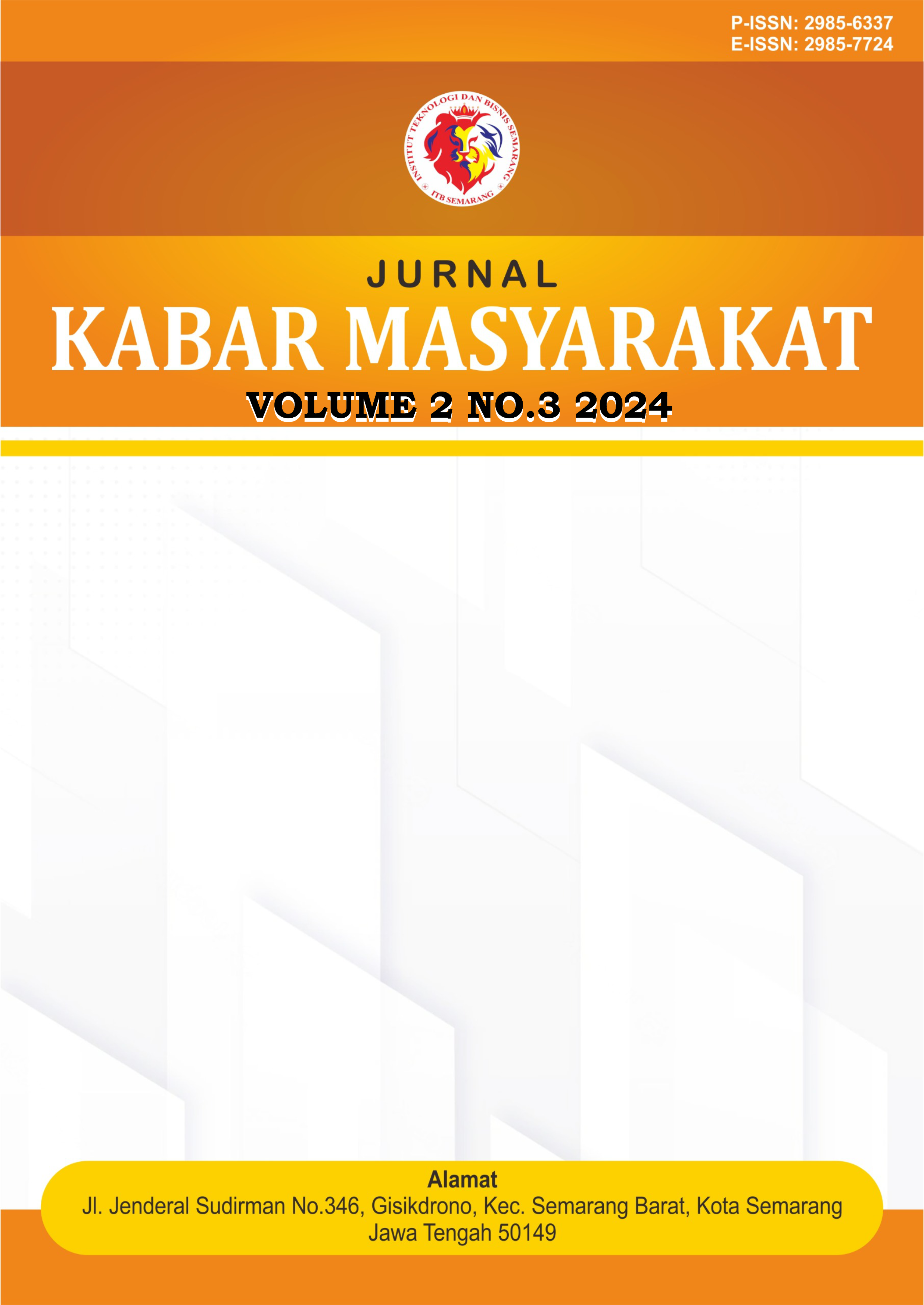Program Pengabdian Masyarakat Untuk Edukasi Dan Deteksi Dini Dislipidemia Dan Obesitas
DOI:
https://doi.org/10.54066/jkb.v2i3.2035Keywords:
Education, Hyperlipidemia, Cardiovascular, Elderly, ScreeningAbstract
Dyslipidemia in the elderly is a serious condition characterized by high or low levels of lipids in the blood, including cholesterol and triglycerides, which increases the risk of cardiovascular disease. In this community service activity, education and health checks were carried out on 94 elderly people at the Bina Bhakti Nursing Home. The results showed that 90.3% of elderly people had normal cholesterol levels, while 9.7% had dyslipidemia. As many as 62.4% had optimal HDL levels, but 37.6% had non-optimal HDL levels. Regarding LDL parameters, 62.4% had optimal levels and 37.6% did not have optimal levels. Dyslipidemia was more common in elderly women (10.8%) than men (5.3%). Modifiable risk factors such as diet and physical activity greatly influence blood lipid levels. Education regarding the importance of a healthy diet and regular health checks is very necessary to manage dyslipidemia in the elderly. This activity emphasizes the importance of a comprehensive educational approach and program to reduce the prevalence of dyslipidemia and improve the quality of life of the elderly.
Keywords: Education, Hyperlipidemia, Cardiovascular, Elderly, Screening
References
Araújo, S. P., Juvanhol, L. L., Bressan, J., & Hermsdorff, H. H. M. (2022). Triglyceride glucose index: A new biomarker in predicting cardiovascular risk. Preventive Medicine Reports, 29(March), 101941. https://doi.org/10.1016/j.pmedr.2022.101941
Ardiani, H. E., Permatasari, T. A. E., & Sugiatmi, S. (2021). Obesitas, Pola Diet, dan Aktifitas Fisik dalam Penanganan Diabetes Melitus pada Masa Pandemi Covid-19. Muhammadiyah Journal of Nutrition and Food Science (MJNF), 2(1), 1. https://doi.org/10.24853/mjnf.2.1.1-12
Barter, P. (2011). HDL-C: Role as a risk modifier. Atherosclerosis Supplements, 12(3), 267–270. https://doi.org/10.1016/S1567-5688(11)70885-6
Breuer, H. W. M. (2001). Hypertriglyceridemia: A review of clinical relevance and treatment options: Focus on cerivastatin. Current Medical Research and Opinion, 17(1), 60–73. https://doi.org/10.1185/0300799039117028
Bromage, S., Pongcharoen, T., Prachansuwan, A., Sukboon, P., Srichan, W., Purttiponthanee, S., Deitchler, M., Moursi, M., Arsenault, J., Ali, N. B., Batis, C., Fawzi, W. W., Winichagoon, P., Willett, W. C., & Kriengsinyos, W. (2023). Performance of the Global Diet Quality Score (GDQS) App in Predicting Nutrient Adequacy and Metabolic Risk Factors among Thai Adults. Journal of Nutrition, 153(12), 3576–3594. https://doi.org/10.1016/j.tjnut.2023.10.007
Destra, E., & Firmansyah, Y. (2022). Intervention Program in Effort to Reduce New Cases. Jurnal Pengabdian Mandiri, 1(5), 677–682.
Ernawati, E., Adjie, E. K. K., Firmansyah, Y., Yogie, G. S., Setyanegara, W. G., & Kurniawan, J. (2023). Pengaruh Kadar Profil Lipid, Asam Urat, Indeks Massa Tubuh, Tekanan Darah, dan Kadar Gula Darah Terhadap Penurunan Kapasitas Vital Paru pada Pekerja Usia Produktif. Malahayati Nursing Journal, 5(8).
Feingold, K. R. (2022). Lipid and Lipoprotein Metabolism. Endocrinology and Metabolism Clinics of North America, 51(3), 437–458. https://doi.org/10.1016/j.ecl.2022.02.008
Gardino, S., Firmansyah, Y., & Naibaho, M. L. (2022). Analisis multivariat faktor risiko metabolik penyebab kejadian Stroke (studi kasus kontrol di Puskesmas Kecamatan Cempaka putih). Jurnal Medika Hutama, 3(3), 2704–2717.
Glavinovic, T., Thanassoulis, G., de Graaf, J., Couture, P., Hegele, R. A., & Sniderman, A. D. (2022). Physiological Bases for the Superiority of Apolipoprotein B Over Low-Density Lipoprotein Cholesterol and Non-High-Density Lipoprotein Cholesterol as a Marker of Cardiovascular Risk. Journal of the American Heart Association, 11(20). https://doi.org/10.1161/JAHA.122.025858
Jellinger, P. S., Handelsman, Y., Rosenblit, P. D., Bloomgarden, Z. T., Fonseca, V. A., Garber, A. J., Grunberger, G., Guerin, C. K., Bell, D. S. H., Mechanick, J. I., Pessah-Pollack, R., Wyne, K., Smith, D., Brinton, E. A., Fazio, S., & Davidson, M. (2017). American association of clinical endocrinologists and american college of endocrinology guidelines for management of dyslipidemia and prevention of cardiovascular disease. Endocrine Practice : Official Journal of the American College of Endocrinology and the American Association of Clinical Endocrinologists, 23, 1–87. https://doi.org/10.4158/EP171764.APPGL
Khatchadourian, C., Sisliyan, C., Nguyen, K., Poladian, N., Tian, Q., Tamjidi, F., Luong, B., Singh, M., Robison, J., & Venketaraman, V. (2021). Hyperlipidemia and Obesity’s Role in Immune Dysregulation Underlying the Severity of COVID-19 Infection. Clinics and Practice, 11(4), 694–707. https://doi.org/10.3390/clinpract11040085
Klop, B., Elte, J. W. F., & Cabezas, M. C. (2013). Dyslipidemia in obesity: mechanisms and potential targets. Nutrients, 5(4), 1218–1240. https://doi.org/10.3390/nu5041218
Krauss, R. M., Pinto, C. A., Liu, Y., Johnson-Levonas, A. O., & Dansky, H. M. (2015). Changes in LDL particle concentrations after treatment with the cholesteryl ester transfer protein inhibitor anacetrapib alone or in combination with atorvastatin. Journal of Clinical Lipidology, 9(1), 93–102. https://doi.org/10.1016/J.JACL.2014.09.013
Miyares, M. A., & Davis, K. (2012). Patient considerations and clinical impact of cholesteryl ester transfer protein inhibitors in the management of dyslipidemia: Focus on anacetrapib. Vascular Health and Risk Management, 8(1), 483–493. https://doi.org/10.2147/VHRM.S29010
Nordestgaard, B. G. (2016). Triglyceride-Rich Lipoproteins and Atherosclerotic Cardiovascular Disease: New Insights from Epidemiology, Genetics, and Biology. Circulation Research, 118(4), 547–563. https://doi.org/10.1161/CIRCRESAHA.115.306249
Quispe, R., Sweeney, T., Varma, B., Agarwala, A., & Michos, E. D. (2022). Recent Updates in Hypertriglyceridemia Management for Cardiovascular Disease Prevention. Current Atherosclerosis Reports, 24(10), 767–778. https://doi.org/10.1007/s11883-022-01052-4
Rosada, A., Kassner, U., Weidemann, F., König, M., Buchmann, N., Steinhagen-Thiessen, E., & Spira, D. (2020). Hyperlipidemias in elderly patients: results from the Berlin Aging Study II (BASEII), a cross-sectional study. Lipids in Health and Disease, 19(1), 92. https://doi.org/10.1186/s12944-020-01277-9
Ruslim, D., Destra, E., Kurniawan, J., & Firmansyah, Y. (2023). Pengaruh Kadar High Density Lipoprotein (HDL) dan Usia terhadap Kejadian Peripheral Arterial Disease (PAD). Jurnal Ilmiah Ilmu Kesehatan Dan Kedokteran, 1(3). https://doi.org/https://doi.org/10.55606/termometer.v1i3.2059
Shaikh, R. F., Ali, M. T., Mohsin, A. A., Hiware, S. D., Ahmad, A., Daimi, S. R. H., Moizuddin, K., Shaikh, S. A., & Siddiqui, F. B. (2022). A Comparative Study on Clinical Evaluation of the Hypolipidemic Effects of Allium sativum, Trigonella foenum-graecum, Commiphora mukul, Picrorhiza kurroa, and Piper nigrum: A Pilot Study. Cureus, 14(7), e26597. https://doi.org/10.7759/cureus.26597
Vekic, J., Stefanovic, A., & Zeljkovic, A. (2023). Obesity and Dyslipidemia: A Review of Current Evidence. Current Obesity Reports, 12(3), 207–222. https://doi.org/10.1007/s13679-023-00518-z







